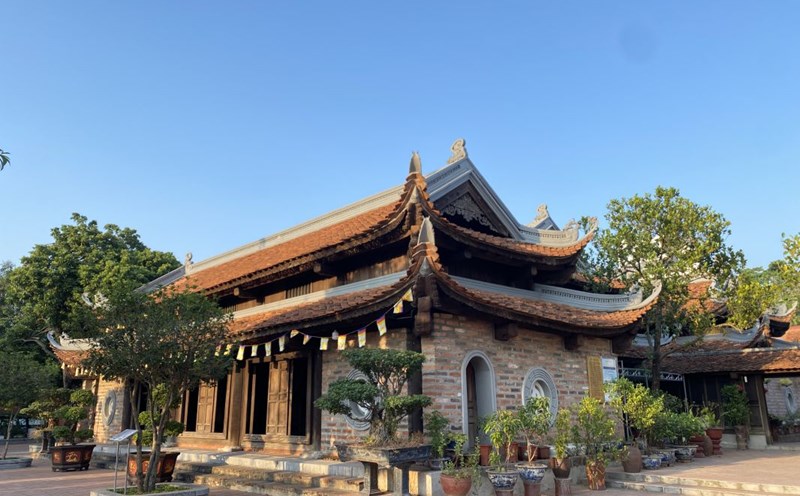With its prime location, majestic landscapes and heroic historical stories, this relic complex has become an invaluable heritage, attracting tourists and worshippers from all over the country.
The status of the royal poinciana and the majestic architecture
Cao An Phu Temple, also known as Cao Temple, has the name of "An Phu Son Tu", located on the top of An Phu mountain, part of a 17km long mountain range, 246m high. From here, visitors can zoom in to the northeast to admire the quiet Yen Tu range, the Northwest is the owner of the owner dubbed the "Nam Thien De Luc cave" with the Kinh River winding close to the foot of the mountain, and the southwest is the immense European region. The harmonious combination between mountains, rivers and plains has created a charming feng shui picture, making this place a worthy landscape to travel.
Cao An Phu Temple is built in the style of "most money" architecture, including money, loyalty and harem. Experiencing many historical events and many restoration, the temple still retains ancient architectural features and preserves many antiques of great historical and cultural values. In particular, at the money, preserving the diaphragm, the sentence praised the merit of An Sinh Vuong Tran Lieu.
Cao An Phu Temple is famous for being a place to worship An Sinh Vuong Tran Lieu (1211 - 1251), the brother of King Tran Thai Tong - the first king of the Tran dynasty. In 1237, the court cut the land of An Phu, An Sinh, An Duong, An Hung and An Bang to establish Thai Hamlet and Phong Ong, An Sinh Vuong Tran Lieu. He and his wife Thien Dao Quoc Mau had great merit in creating the genius of the Kingdom of the Hung Dao Dai Vuong Tran Quoc Tuan - the son of Trung Hieu, the national hero, Van martial arts, who led the Dai Viet army 3 times to defeat the Yuan Mong invaders.
After An Sinh Vuong Tran Lieu died on April 1, 1251, the people set up his temple on the top of An Phu mountain to remember the gratitude. Since then, on the first day of the 4th lunar month every year becomes a Cao An Temple Festival, attracting a large number of people and tourists from all over the world to offer incense and gratitude to merit. The harem of the temple is not only the statue of Tran Lieu but also worshiping the first king and the second king, the two daughters of Hung Dao Dai Vuong Tran Quoc Tuan, who was chanted as very sacred.
Diverse and meaningful relic complex
The An Phu relic complex not only includes the Cao Temple but also includes many other unique architectural works and attractions, creating a harmonious and meaningful whole. Located slightly lower than Cao Temple, Tuong Van Pagoda (also known as Cao Pagoda) is an ancient pagoda built in the 13th century, during the Tran Dynasty.
In front of the temple, there were two ancient trees over 700 years old, towering like historical witnesses witnessed the ups and downs of this land. Despite many restoration, Tuong Van pagoda still retains the ancient and mossy appearance. The special feature of the pagoda is to worship the three religions, with the Buddha statues, the statue of the Holy Holy and the Jade Emperor statue, showing the harmony between the three major religions of Vietnam: Buddhism, Confucianism and Taoism. From Tuong Van Pagoda, visitors can look to the Northeast, where the sacred Yen Tu mountain - the cradle of Truc Lam Zen of Vietnam. On the left of Tuong Van pagoda is the Tu Phu temple.
Another highlight in the relic complex is the statue of the secretary of Hung Dao Dai Vuong Tran Quoc Tuan, located on a mountain of An Phu, 200m higher than sea level, lower than An Sinh Vuong Cao Temple. The statue is sculpted with green rocks in Thanh Hoa mountain, 9.7m high (some documents recorded 12.7m and grafted from 65 stones). The statue shows a martial arts general, portrait of the ruler but the kindness, the hand of the Sword, the hand holding the letter, looking east of the Bach Dang mouth, reminding the posterity to always pay attention to preserve and protect the homeland of the country. In particular, the first stone placed at the position of building a monument on October 5, 1993 was General Vo Nguyen Giap.
Right at the foot of Hung Dao Vuong monument is a giant ceramic relief, 45m long, 2.5m wide on average, made of 265 bricks, summarizing the entire resistance war of the Dai Viet people against the Mong army in the 13th century.
In the temple grounds, there are many ancient trees 600 - 700 years old and sacred water sources that never dry up from the Pearl well and the Dragon Eye well, proving the longevity of the relic site. The antiques preserved at the temple from ancient times have brought great historical and cultural values to posterity.
Cao An Phu Temple is not only a destination for worship and pray for peace, but also a space for visitors to immerse themselves in the historical flow, feel the spirit of Dong A and the sacredness of a land of the sacred and wonderful. Hopefully in the future, Cao An Phu Temple will be increasingly preserved, its value will be promoted and it will become an un must-see destination on the map of Vietnam's spiritual tourism.
With its special historical, cultural and architectural values, in 1992, the historical, cultural and scenic relic Cao An Phu Temple was ranked as a national relic. On December 22, 2016, the An Phu - Kinh Chu - Nham Duong relic site of Kinh Mon town was ranked by the State as a special national relic complex, becoming the second relic site of Hai Duong to be recognized after Con Son - Kiep Bac.











